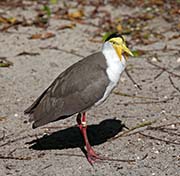Masked Lapwing - Vanellus miles
| Length | |
| Wingspan | |
| Weight | |
| Clutch Size | |
| Chicks at birth | |
| IUCN Conservation Status | |
Continents: |
The Masked Lapwing is also known as the Masked Plover or Spur-winged Plover and is native to Australia. and any interference with the bird, nest or eggs is not permitted.
Masked Lapwings are ground dwellers and have a white collar, white underparts, brown wings, black crown and nape and a yellow bill and wattle that extends behind the eye and hangs down the chin. They have bony spurs protruding from their shoulders. Both sexes are similar. Juvenile are also similar to adults but their coloration is duller and the tops of their wings are mottled.
One of the interesting things I discovered about this bird is that they are very aggressive during breeding season. The Tasmanian web site (listed under the bibliography below) had some great do's and don't's for this bird during breeding season. My favorite "Do" was: "Hold or wave a stick or flag above your head. A supply of decorated sticks with flags on can be stocked where, for example, schoolchildren have to cross swoop-prone open spaces;"
Another interesting factoid is their relationship to airplanes. Because they like to nest and/or feed around airports, they are prone to being struck by airplanes. Some of the efforts to discourage their presence besides removing the eggs, relocation of nests, etc. is to change the environment near the runways to make it less desirable. This includes letting the grass longer or letting native bushes grow there.
It's scientific name miles means soldier in latin and refers to the spurs on its wing.
Diet: Worms, insects, and crustaceans. They also will eat leaves, seeds and some frogs. They look for food just below the surface of the ground or on the ground. Not sure if they scrape the dirt with their feet or use their beaks to dig for the food under the ground.
Courtship: Masked Lapwings flock together during the non-breeding season and then pair off for breeding. Breeding usually happens after the Southern Hemisphere's Winter Solstice (June 21). I didn't find any information on their courtship.
Nesting: Nests are built on the ground in a shallow depression. It looks like the nest is surrounding by cut grass. While they prefer building their nests near water, Masked Lapwings will nest in almost any urban setting including air strips, golf courses, etc. The nesting pair will defend their nesting territory by calling loudly, spreading their wings, and then swooping fast and low and striking at interlopers with their feet and their yellow spur on the carpal joint of the wing. This can be a problem because they are so aggressive during the breeding season and will harass and even injure other birds, dogs, cats and rarely people.
Masked Lapwings breed once a year and the female lays 3-4 eggs. Both parent incubate the eggs and feed the chicks. The chicks are precocial and can leave the nest after birth. They can see and are covered with down. They fledge in 6-7 weeks.
Habitat and Range: Masked Lapwings are found throughout Australia, southern New Guinea and New Zealand. They are ground dwellers and are mostly found around the edges of wetlands and prefer open spaces. They are also be found on beaches, coastlines, and urban areas (such as airports, golf courses).
Vocalization: Wide range of calls for courtship, defending territory, and warning.
Plumage/Molt: No alternate plumage.
Migration: Non-migratory
Tongue/feet: Their feet and legs are reddish pink.
Bibliography:
- http://en.wikipedia.org The Free Encyclopedia, Accessed June, 2012
- http://www.dpiw.tas.gov.au/inter-nsf/WebPages/LJEM-6FSV2E?open Tasmania Australian Department of Primary Industries, Parks, Water and Environment, Accessed June, 2012
- http://www.atsb.gov.au/media/36504/03_masked-lapwings.pdf Australian Transport Safety Bureau, Accessed June, 2012





